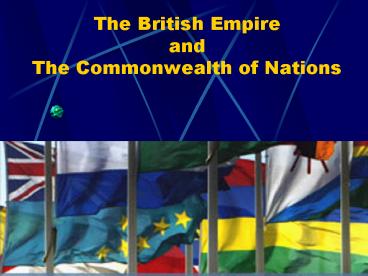The British Empire and The Commonwealth of Nations - PowerPoint PPT Presentation
1 / 21
Title:
The British Empire and The Commonwealth of Nations
Description:
The British Empire and The Commonwealth of Nations The Sun Never Sets on the British Empire The building of the Empire began with a sea voyage to North America in 1497. – PowerPoint PPT presentation
Number of Views:112
Avg rating:3.0/5.0
Title: The British Empire and The Commonwealth of Nations
1
The British Empireand The Commonwealth of
Nations
2
The Sun Never Sets on the British Empire
- The building of the Empire began with a sea
voyage to North America in 1497. - The arms of the Empire stretched far and wide.
- Because it was so widespread, it would always be
daylight in some part.
3
(No Transcript)
4
The Union Jack
5
Flag Quiz
6
Flag Quiz...answers
- The Union Jack
- The New Zealand Flag
- The Australian Flag
- The Fiji Flag
7
The British Empire
- was the largest empire in history.
- was for a substantial time the foremost global
power. - was a product of the European age of discovery,
which began with the maritime explorations of the
15th century, that started the era of the
European colonial empires. - During the five decades following World War II,
most of the territories of the Empire became
independent. - Many went on to join the Commonwealth of Nations,
a free association of independent states.
8
The Commonwealth of Nations engages in work to
promote international understanding and world
peace. The citizens of the Commonwealth are
drawn from the broadest range of faiths, races,
cultures and traditions.
9
Flag of the Commonwealth of Nations
10
World map The Commonwealth of Nations 2006
Current member states are coloured blue
11
The Commonwealth
- is a group of fifty-three of the world's
countries. - countries used to be part of the British Empire.
- has a combined population of 1.9 billion people.
- has about a quarter of the worlds total
population. - has over twice as many people as the whole of the
Americas (North and South) put together. - Of the 1.9 billion people, 1.4 billion live in
the Indian Subcontinent. - 93 live in Asia or Africa.
12
Flags of the members of the Commonwealth in Horse
Guards Road next to the Foreign and Commonwealth
Office in London.
13
Foreign and Commonwealth Office
14
Declarations and Statements
- The Commonwealth does not have a written
constitution. - It does have a series of agreements.
- Declarations or Statements have been issued at
various Commonwealth Heads of Government
Meetings. - The first, fundamental statement was issued at
the 1971 summit in Singapore. - The Declaration of Commonwealth Principles
stresses the need to foster - international peace and security
- democracy
- liberty of the individual and equal rights for
all - the importance of eradicating poverty, ignorance
and disease - it opposes all forms of racial discrimination.
- Foreign Office Grand Staircase
15
Queen Elizabeth is Head of the Commonwealth
- The British monarch, Queen Elizabeth, is a symbol
of the free association of independent states. - Republics could be members - they could accept
the monarch as Head of the Commonwealth without
her being their own Head of State. - When Elizabeth II came to the throne in 1952 she
became Head of the Commonwealth. - Today the Queen is Head of State in 16 of the 53
Commonwealth member countries - When the Queen dies or if she abdicates, her heir
will not automatically become Head of the
Commonwealth. - The Queen has laid considerable stress on her
role as Head of the Commonwealth, and made a
great contribution to the association.
16
Her Majestys Government Coat of Arms
17
The Foreign and Commonwealth Office
- Her Majestys Principal Secretary of State for
Foreign and Commonwealth Affairs, is a member of
the British Government. - He/she is responsible for relations with foreign
countries. - He/she heads the Foreign and Commonwealth Office.
- Current Foreign Secretary
- David Miliband
18
Current Members
- Africa
- Botswana (1966)
- Cameroon (1995)
- Gambia (1965)
- Ghana (1957)
- Kenya (1963)
- Lesotho (1966)
- Malawi (1964)
- Mauritius (1968)
- Mozambique (1995)
- Namibia (1990)
- Nigeria (1960 suspended in 1995 readmitted in
1999) - Seychelles (1976)
- Sierra Leone (1961)
- South Africa (1931 left in 1961 rejoined in
1994) - Swaziland (1968)
- Tanzania (1961)
- Uganda (1962)
- Zambia (1964)
19
Current Members
- Asia
- Bangladesh (1972)
- Brunei (1984)
- India (1947)
- Malaysia (1957 as Malaya Malaysia since 1963)
- Maldives (1982)
- Pakistan (1947 left in 1972 rejoined 1989
suspended in 1999 readmitted in 2004) - Singapore (1965)
- Sri Lanka (1948)
20
Current Members
- Oceania
- Australia (1931 ratified in 1942)
- Kiribati (1979)
- Nauru (1968)
- New Zealand (1931 ratified in 1947)
- Papua New Guinea (1975)
- Samoa (1970)
- Solomon Islands (1978)
- Tonga (1970)
- Tuvalu (1978)
- Vanuatu (1980)
- Europe
- Cyprus (1961)
- Malta (1964)
- United Kingdom (1931)
21
Current Members
- North America
- Antigua and Barbuda (1981)
- Bahamas (1973)
- Barbados (1966)
- Belize (1981)
- Canada (1931)
- Dominica (1978)
- Grenada (1974)
- Jamaica (1962)
- Saint Kitts and Nevis (1983)
- Saint Lucia (1979)
- Saint Vincent and the Grenadines (1979)
- Trinidad and Tobago (1962)
- South America
- Guyana (1966)






























